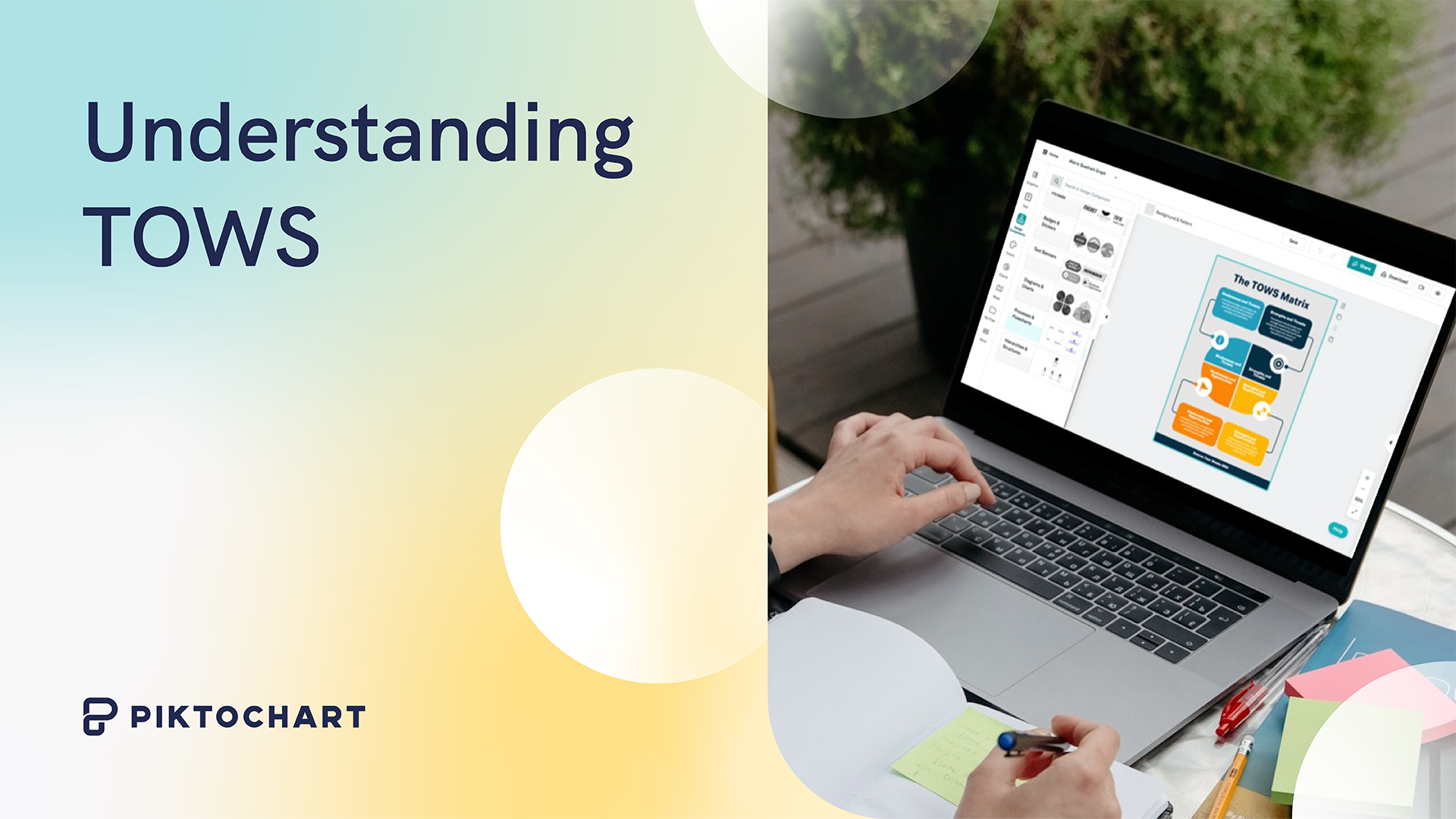In today’s competitive business landscape, having an edge is crucial, and being able to be strategic is non-negotiate. Welcome to the world of TOWS, a nuanced twist on the classic SWOT analysis.
If you’ve navigated the situational analysis of Strengths, Weaknesses, Opportunities, and Threats, it’s time to delve deeper. TOWS isn’t just SWOT spelled backward—it’s a unique strategic planning tool that shifts our perspective, turning potential threats into promising strategies.
Table Of Contents
Want to refresher on the basics of SWOT analysis? Take a look at this SWOT guide. Sign up to create a free Piktochart account and access hundreds of customizable SWOT templates for a variety of purposes.
What is TOWS analysis?
In the realm of strategic analysis, both SWOT and TOWS serve as critical tools, dissecting internal and external business facets. But here’s the catch: TOWS dives deeper. It’s not just about listing Strengths, Weaknesses, Opportunities, and Threats—TOWS analysis focuses on interconnecting these internal and external factors, turning perceived challenges into breakthrough strategies.
Internal Factors:
– Strengths: These are the unique attributes propelling your business ahead of the competition.
– Weaknesses: Conversely, these are the areas where your enterprise might trail behind its peers.
But, when we pivot to the external environment, it’s more than just opportunities and threats; it’s about understanding the macro landscape.
External Factors:
– Opportunities: These are external avenues ripe for the taking, allowing your business to thrive and grow.
– Threats: These can be barriers or disruptions, external elements that, if not navigated correctly, could hamper progress.
And when discussing these external dynamics, it’s essential to gauge nuances like the competitive landscape, burgeoning international markets, the weight of brand recognition, the stringency of government regulations, and the overarching economic climate.
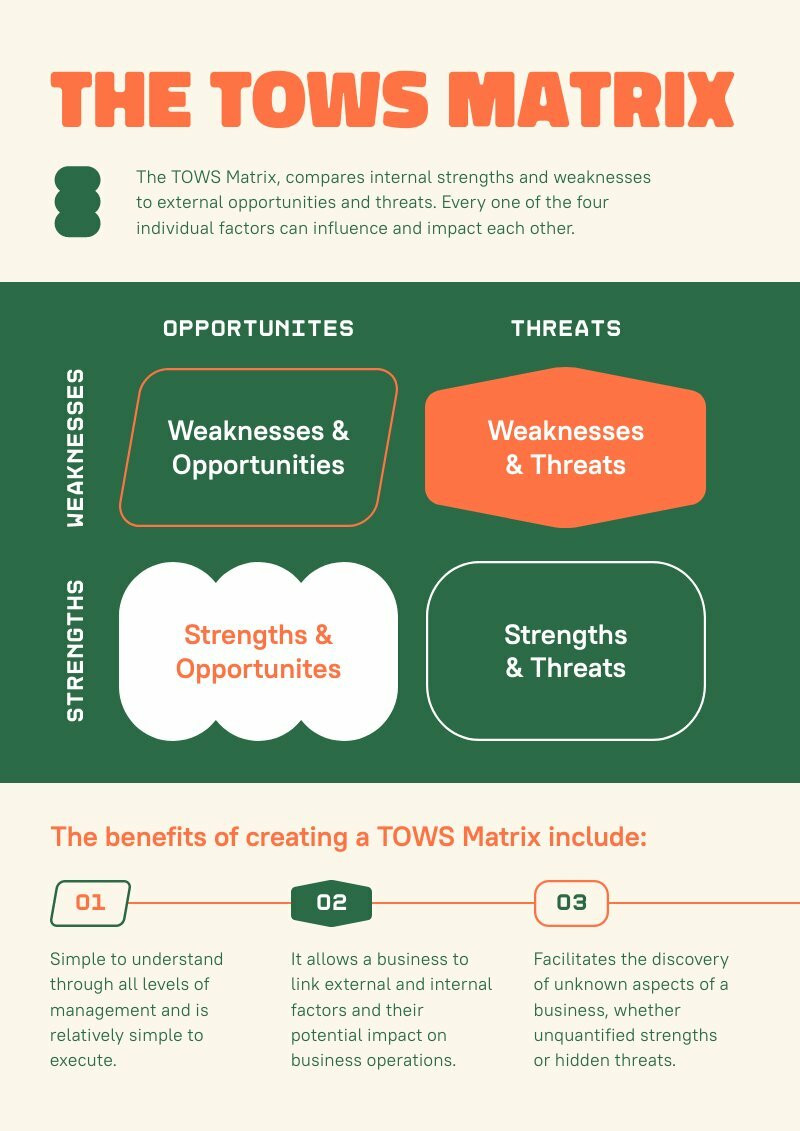
Mini Maxi Strategy
Now, delving into strategy design, consider the “Mini-Maxi Strategy”: it’s about turning modest assets into monumental advantages. Even if one’s business operations might not boast significant strengths, there’s always room to harness maximal opportunities—TOWS embodies this philosophy.
Broadening the perspective, the strategic matrix gets even more intricate:
– Maxi-Maxi Strategy: Amplifying inherent strengths to seize golden opportunities.
– Mini-Mini Strategy: Tactfully sidestepping weaknesses and navigating clear of looming threats.
– Maxi-Mini Strategy: Employing robust strengths to deflect or overcome challenges.

Remember, in the world of strategy, it’s not about what you face but how you face it. Let TOWS be your compass.
What is the difference between SWOT and TOWS?
SWOT framework provides us with a snapshot, a clear-cut grid of Strengths, Weaknesses, Opportunities, and Threats. It’s about awareness of the internal and external forces.
TOWS, on the other hand, delves deeper. It’s the art of connecting these dots—how can we leverage Strengths to exploit Opportunities or use Strengths to counteract Threats? It pushes us beyond mere identification, into the realm of strategic options.
SWOT sets the stage, TOWS directs the play.
How does TOWS work?
Understanding the TOWS Matrix: TOWS Matrix Breakdown
The TOWS analysis takes a meticulous lens, allowing businesses to convert their internal strengths and weaknesses into strategies by considering external opportunities and threats. Let’s dissect this essential tool:
1. Strengths/Opportunities (SO):
The SO quadrant is about harnessing power. It asks the question: “How can we utilize our strengths to maximize available opportunities?” This is where a business’s core competencies meet external avenues for growth or expansion. Think of it as aligning your best assets with the most promising prospects.
2. Strengths/Threats (ST):
Here’s where defense meets offense. The ST strategic position focuses on: “How can our inherent strengths help mitigate external threats?” This segment illuminates pathways where a business’s robust areas can act as a bulwark against potential challenges, turning adversities into manageable risks.
3. Weaknesses/Opportunities (WO):
The WO quadrant is all about transformative thinking. It prompts: “How can we turn our internal weaknesses into an advantage by leveraging external opportunities?” It’s about recognizing areas of improvement and aligning them by making informed business decisions to evolve, adapt, and innovate.
4. Weaknesses/Threats (WT):
Arguably the most challenging quadrant, WT demands a proactive stance. The focus is: “How can we devise strategies to shield our vulnerabilities from potential external threats?” It’s about how do we minimize weaknesses: risk management and preemptive action, ensuring weaknesses aren’t further exposed by looming threats, leaving the company vulnerable.
Mastering the TOWS matrix means juggling these perspectives, ensuring a comprehensive, 360-degree detailed analysis of one’s strategic landscape.
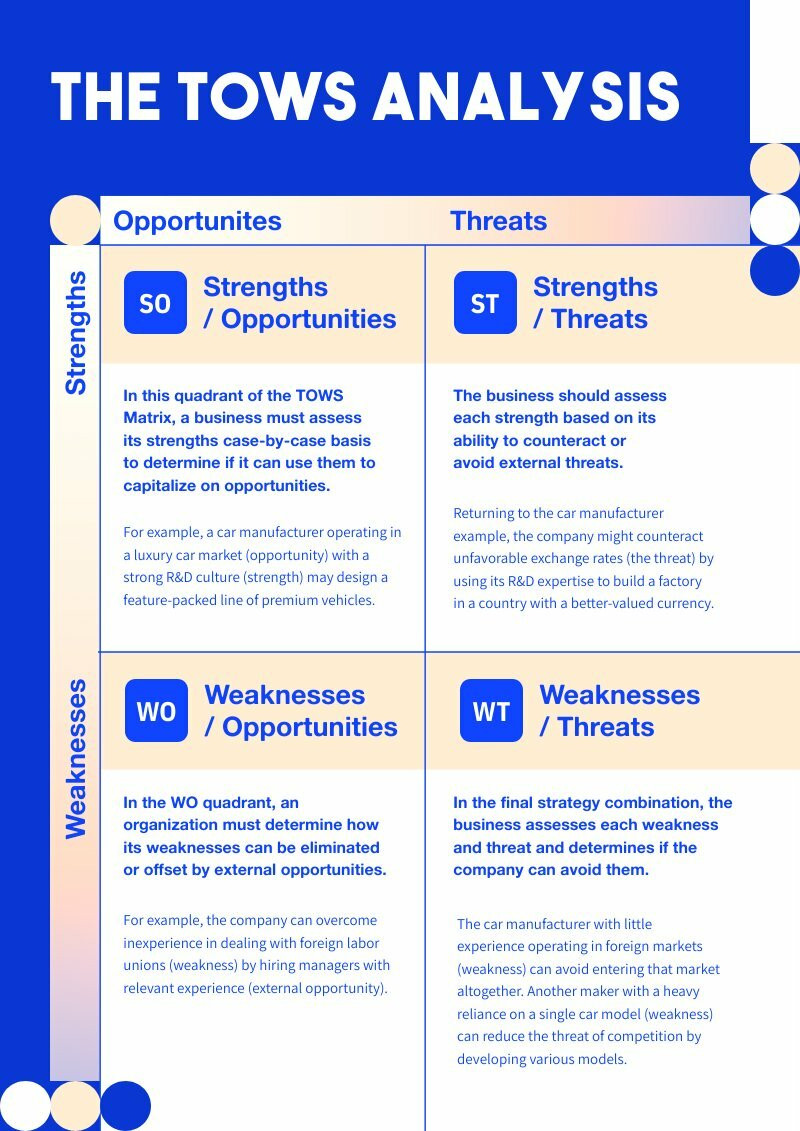
Two examples of TOWS analysis for strategic planning
The following is done without data analytics, which clearly is required if one was to undertake TOWS. The first step would be doing the SWOT analysis, before doing TOWS.
TOWS Matrix for TikTok
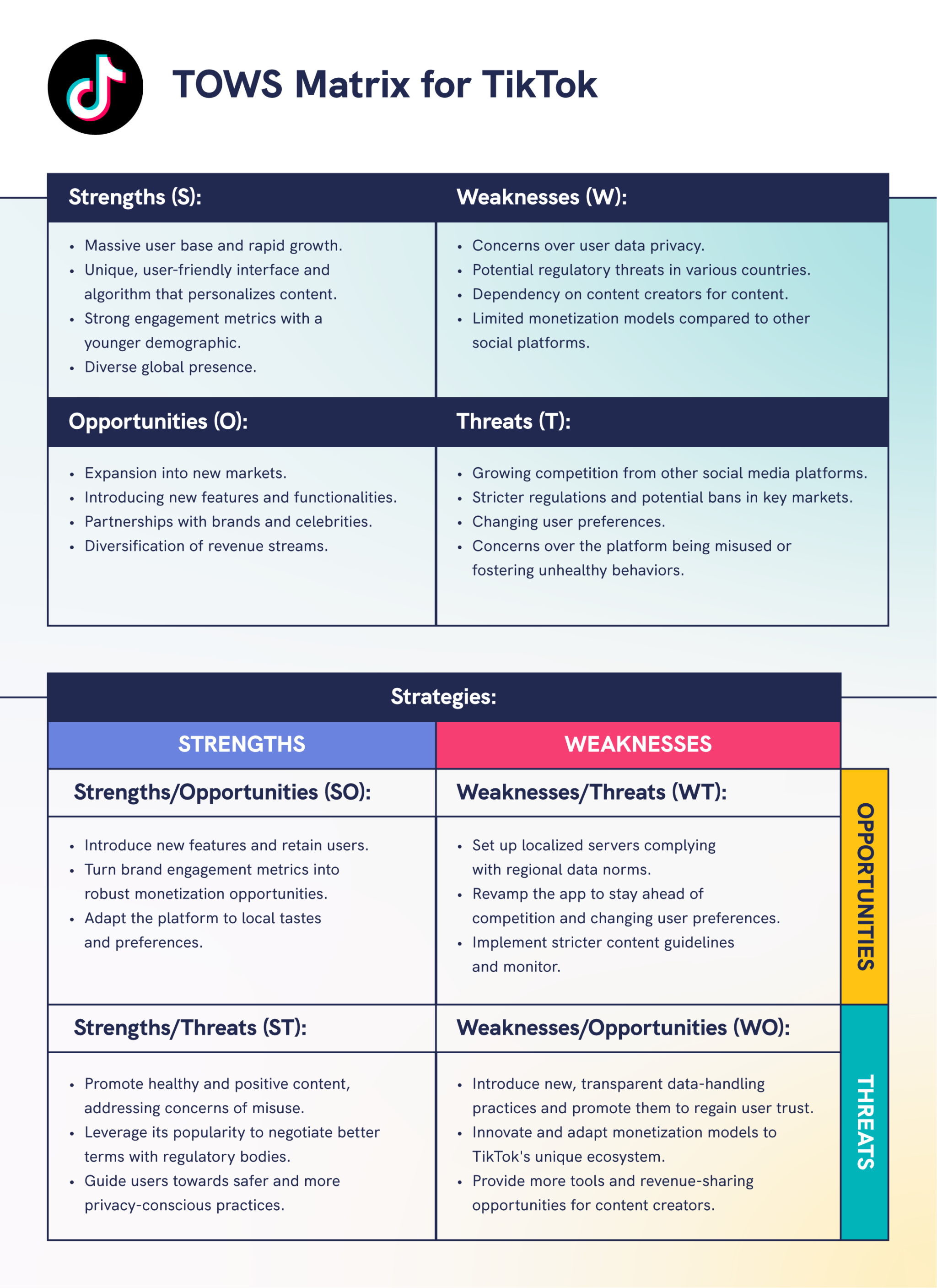
Strengths (S):
1. Massive user base and rapid growth.
2. Unique, user-friendly interface and algorithm that personalizes content.
3. Strong engagement metrics with a younger demographic.
4. Diverse global presence.
Weaknesses (W):
1. Concerns over user data privacy.
2. Potential regulatory threats in various countries.
3. Dependency on content creators for content.
4. Limited monetization models compared to other social platforms.
Opportunities (O):
1. Expansion into new markets.
2. Introducing new features and functionalities.
3. Partnerships with brands and celebrities.
4. Diversification of revenue streams.
Threats (T):
1. Growing competition from other social media platforms.
2. Stricter regulations and potential bans in key markets.
3. Changing user preferences.
4. Concerns over the platform being misused or fostering unhealthy behaviors.
—
Strategies:
1. Strengths/Opportunities (SO):
– Leverage its strong user base to introduce new features and retain users.
– Expand partnerships with brands, turning engagement metrics into robust monetization opportunities.
– Use its global presence to tap into untouched markets, adapting the platform to local tastes and preferences.
2. Strengths/Threats (ST):
– Utilize the platform’s unique algorithm to promote healthy and positive content, addressing concerns of misuse.
– Engage in active dialogue with regulatory bodies, especially in the US, leveraging its popularity to negotiate better terms.
– Use its user-friendly interface to guide users towards safer and more privacy-conscious practices.
3. Weaknesses/Opportunities (WO):
– Address data privacy concerns by introducing new, transparent data-handling practices and promote them to regain user trust.
– Innovate monetization models, looking at successful practices from competitors and adapting them to TikTok’s unique ecosystem.
– Foster closer ties with content creators, providing them with more tools and revenue-sharing opportunities.
4. Weaknesses/Threats (WT):
– Proactively address regulatory concerns by setting up localized servers and complying with regional data norms.
– Continuously innovate and revamp the app to stay ahead of competition and changing user preferences.
– Implement stricter content guidelines and monitoring to address concerns of misuse and unhealthy behaviors.
TOWS Matrix for Shell
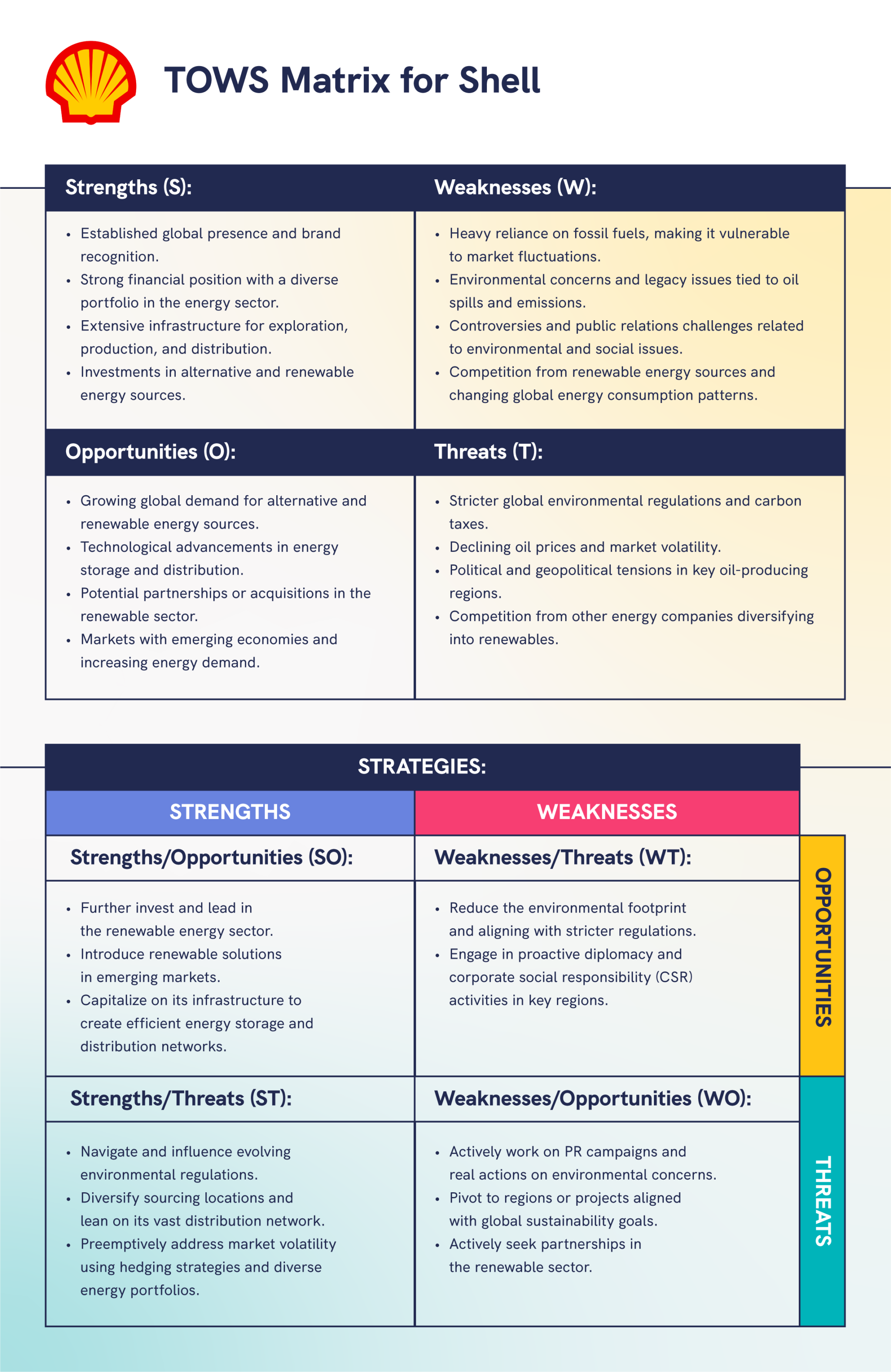
Strengths (S):
1. Established global presence and brand recognition.
2. Strong financial position with a diverse portfolio in the energy sector.
3. Extensive infrastructure for exploration, production, and distribution.
4. Investments in alternative and renewable energy sources.
Weaknesses (W):
1. Heavy reliance on fossil fuels, making it vulnerable to market fluctuations.
2. Environmental concerns and legacy issues tied to oil spills and emissions.
3. Controversies and public relations challenges related to environmental and social issues.
4. Competition from renewable energy sources and changing global energy consumption patterns.
Opportunities (O):
1. Growing global demand for alternative and renewable energy sources.
2. Technological advancements in energy storage and distribution.
3. Potential partnerships or acquisitions in the renewable sector.
4. Markets with emerging economies and increasing energy demand.
Threats (T):
1. Stricter global environmental regulations and carbon taxes.
2. Declining oil prices and market volatility.
3. Political and geopolitical tensions in key oil-producing regions.
4. Competition from other energy companies diversifying into renewables.
—
Strategies:
1. Strengths/Opportunities (SO):
– Leverage its strong financial position to further invest and lead in the renewable energy sector.
– Use its global presence to introduce renewable solutions in emerging markets.
– Capitalize on its infrastructure to create efficient energy storage and distribution networks.
2. Strengths/Threats (ST):
– Use its financial strength and global presence to navigate and influence evolving environmental regulations.
– Address geopolitical tensions by diversifying sourcing locations and leaning on its vast distribution network.
– Apply its experience in the energy market to preemptively address market volatility, using hedging strategies and diverse energy portfolios.
3. Weaknesses/Opportunities (WO):
– Actively work on PR campaigns and real actions to address environmental concerns, positioning Shell as a leader in sustainable energy.
– Pivot from regions or projects with high controversies to ones aligned with global sustainability goals.
– Actively seek partnerships in the renewable sector to mitigate the effects of competition and changing energy consumption trends.
4. Weaknesses/Threats (WT):
– Invest in R&D to improve operational efficiencies, reducing the environmental footprint and aligning with stricter regulations.
– Engage in proactive diplomacy and corporate social responsibility (CSR) activities in key regions to address and prevent potential geopolitical issues.
In the constantly shifting landscape of business strategy, tools like the TOWS matrix remain indispensable. They offer clarity, direction, and a roadmap to navigate complexities. As leaders, it’s not just about identifying challenges, but harnessing them, turning potential pitfalls into stepping stones towards success.
Piktochart offers professionally-designed templates to create reports, presentations, brochures, and more. Sign up for a free account today to create impressive visuals within minutes.
Ready to strategize with TOWS
Edit our TOWS template and take your business planning to the next level!
Sign up for Piktochart now
